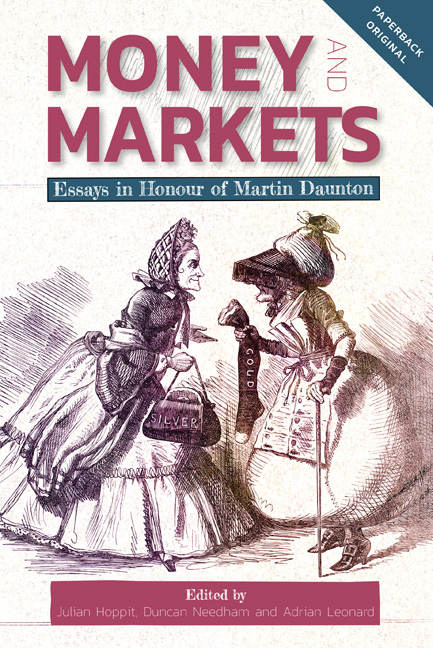Book contents
- Frontmatter
- Contents
- List of Figures
- List of Tables
- List of Contributors
- List of Abbreviations
- Introduction
- 1 Taxing London and the British Fiscal State, 1660–1815
- 2 Rents, Squalor, and the Land Question: Progress and Poverty
- 3 Marine Insurers, the City of London, and Financing the Napoleonic Wars
- 4 The Political Economy of Sir Robert Peel
- 5 Champagne Capitalism: France’s Adaptation to Britain’s Global Hegemony, 1830–80
- 6 The 1848 Revolution in Prussia: a Financial Interpretation
- 7 Imperial Germany, Great Britain and the Political Economy of the Gold Standard, 1867–1914
- 8 Knowledge, Contestation and Authority in the Eurodollar Market, 1959–64
- 9 Continuity and Change in British Conservative Taxation Policy, c. 1964–88
- 10 Britain Since the 1970s: a Transition to Neo-Liberalism?
- 11 Maplin: the Treasury and London’s Third Airport in the 1970s
- 12 Workfare and the Reinvention of the Social in America and Britain, c. 1965 to 1985
- 13 Charity and International Humanitarianism in Post-War Britain
- 14 Discounting Time
- 15 The Material Politics of Energy Disruption: Managing Shortages Amidst Rising Expectations, Britain 1930s–60s
- The Published Writings of Martin J. Daunton
- Index
- People, Markets, Goods: Economies and Societies in History ISSN: 2051-7467
12 - Workfare and the Reinvention of the Social in America and Britain, c. 1965 to 1985
Published online by Cambridge University Press: 13 April 2021
- Frontmatter
- Contents
- List of Figures
- List of Tables
- List of Contributors
- List of Abbreviations
- Introduction
- 1 Taxing London and the British Fiscal State, 1660–1815
- 2 Rents, Squalor, and the Land Question: Progress and Poverty
- 3 Marine Insurers, the City of London, and Financing the Napoleonic Wars
- 4 The Political Economy of Sir Robert Peel
- 5 Champagne Capitalism: France’s Adaptation to Britain’s Global Hegemony, 1830–80
- 6 The 1848 Revolution in Prussia: a Financial Interpretation
- 7 Imperial Germany, Great Britain and the Political Economy of the Gold Standard, 1867–1914
- 8 Knowledge, Contestation and Authority in the Eurodollar Market, 1959–64
- 9 Continuity and Change in British Conservative Taxation Policy, c. 1964–88
- 10 Britain Since the 1970s: a Transition to Neo-Liberalism?
- 11 Maplin: the Treasury and London’s Third Airport in the 1970s
- 12 Workfare and the Reinvention of the Social in America and Britain, c. 1965 to 1985
- 13 Charity and International Humanitarianism in Post-War Britain
- 14 Discounting Time
- 15 The Material Politics of Energy Disruption: Managing Shortages Amidst Rising Expectations, Britain 1930s–60s
- The Published Writings of Martin J. Daunton
- Index
- People, Markets, Goods: Economies and Societies in History ISSN: 2051-7467
Summary
The Prime Minister saw the Panorama programme last night about ‘Workfare’ in the US. She was impressed by the way it helped both the unemployed themselves – through the chance it gives them to keep in touch with the world of work, to get out of the house and to do something of value – and the taxpayer, through the work done in return for welfare payments. Many of the unemployed who were interviewed liked it; the cities liked it; the unions often at least did not object and some supported it.
It was in April 1986 – with British unemployment standing at a record 3.3 million – that Margaret Thatcher's evening in front of her Downing Street television set prompted her private Secretary David Norgrove to write a letter recommending workfare to several Whitehall departments. He went on to state that, while ‘the adoption of “Workfare” in this country has been studied before … the arguments for it are very strong’. Clearly Thatcher wished her government to (re)examine an approach to social policy that, in her eyes, promised to address Britain's unemployment problem in a constructive manner.
In the 1980s the notion of workfare began to meander through British social policy discussions. A neologism blending the words ‘welfare’ and ‘work’, the term captured a widening desire among policymakers to demand that recipients of social security payments accept employment or risk the withdrawal of benefits. Workfare, in short, required people on welfare to work – or lose financial support. That the British governments of the eighties emerged among the first administrations in Europe to debate workfare seriously as a policy option is hardly a surprise. Since workfare promised to raise the number of Britons in employment, it held out the prospect of reducing the monthly unemployment count that presented a major political embarrassment for the Thatcher government for much of the eighties. Unemployment rose dramatically during the recession in the early part of the decade and remained at high levels until 1986. By promising to integrate welfare recipients into the working population, workfare offered not just an opportunity to reduce unemployment figures; it also appeared to address what many cultural conservatives viewed as a prime cause of a moral crisis that supposedly afflicted post-war Britain.
- Type
- Chapter
- Information
- Money and MarketsEssays in Honour of Martin Daunton, pp. 217 - 234Publisher: Boydell & BrewerPrint publication year: 2019

